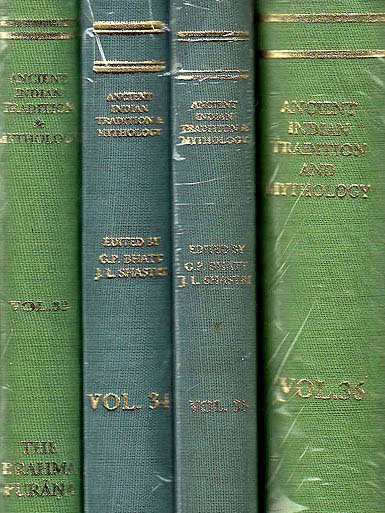The Brahma Purana
by G. P. Bhatt | 1955 | 243,464 words
This is the Brahma Purana in English (translation from Sanskrit), which is one of the eighteen Maha Puranas. The contents of this ancient Indian encyclopedic treatise include cosmology, genealogy (solar dynasty etc.), mythology, geology and Dharma (universal law of nature). The Brahma Purana is notable for its extenstive geological survey includin...
Chapter 17 - Jambūdvīpa
Lomaharṣaṇa said:
1. To the north of ocean and to the South of Himālayas is the sub-continent Bhārata. The subjects are called Bhāratis.
2. O leading sages, its extent is nine thousand Yojanas. This is the land of holy rites to those who opt for heavenly pleasure and absolution.
3. The seven Kulaparvatas are Mahendra, Malaya, Sahya, Śūktimān, Ṛkṣa, Vindhya and Pāriyātra
4. It is from here, O brahmins, that the heaven is attained; one attains absolution too from here, men attain the state of different species of animals or fall in hell from here alone.
5. It is from here alone that men go to heaven or realize absolution at the end of their series of birth. Nowhere else on the earth are holy rites prescribed for men.
6-8. Listen to the nine divisions of this sub-continent. The are Indradvīpa, Kaserumān, Tāmraparṇa, Gabhastimān, Nāgadvīpa, Saumya, Gāndharva and Vāruṇa.
Bhārata, the ninth among them, is an island encircled by the ocean. This island extends from South to North a thousand Yojanas.
Kirātas stay in the East, Yavanas stay in the West.
9. Brahmins, Kṣatriyas and Vaiśyas stay in the centre. Śūdras stay everywhere. These people have their means of subsistence in sacrifice, battle, trade and service.
10. O sage, the Śatadrū, Candrabhāgā and other rivers have their source at the foot of the Himavān. The Vedasmṛti and other rivers originate from the Pāriyātra.
11-14. The Narmadā, Surasā and other rivers flow from the Vindhya. The Tāpī, Payoṣṇī, Nirvindhyā, Kāverī and other rivers flow from the foot of the Ṛkṣa mountain and as it is well known they dispel sin.
The Godāvarī, Bhīmarathī, Kṛṣṇaveṇī and other rivers originate from the foot of Sahya. As it is said they dispel the fear of sins. The Kṛtamālā, Tāmraparṇī and other rivers start from Malaya. The Trisandhyā, Ṛṣikulyā and other rivers have their source in Mahendra. The Ṛṣikulyā, Kumāra and other rivers flow from the foot of Śūktimān.
15-19. There are thousands of tributaries and branches of these rivers. The people of this land bathe in and drink their waters. They are the Kurus, Pañcālas, the people of middle land, eastern lands, residents of Kāmarūpa; people of southern territories such as Pauṇḍras, Kaliṅgas and others. The Parāntyas (westerners), Saurāṣṭras, Śūdras, Ābhīras, Arbudas, Murukas, Mālavas, residents of Pāriyātra, Sauvīras, Saindhavāpannas, Śālvas, residents of Śākala territory, Madrārāmas, Ambaṣṭhas, Pārasīkas and others. They drink waters of these rivers and stay on their banks. They are highly blessed, hale and hearty.
20. O great sage, the four Yugas, viz. Kṛta, Tretā, Dvāpara and Kali are reckoned only in Bhārata and nowhere else.
21. The ascetics perform penance here; the Yajvins perform sacrifices; people give charitable gifts with devotion to obtain heaven.
22. Here, in the Jambūdvīpa the Supreme Being is worshipped through sacrifices. It is Viṣṇu who is identified with sacrifice that is worshipped. In other Dvīpas he is worshipped otherwise.
23. O great sage, in the Jambūdvīpa, it is the subcontinent Bhārata which is most excellent since it is the land of holy rites and activities. Others are the regions of enjoyment.
24. Here, O excellent one, after thousands and thousands of birth alone does a creature attain human birth sometimes through the accumulation of merits.
25-29. It is said that Devas sing (its praise thus):—“Blessed are they who are born (again and again) as men in Bhārata which is the source of heavenly pleasures as well as liberation.
Holy rites should be performed in utter disregard of their benefits. They must be dedicated to Viṣṇu identical with the Ātman. Those who are pure attain birth in the land of holy rites (i.e. Bhārata) and get merged into that infinite Being (after death)”. We do know that when the merit that had originally yielded heavenly pleasures subsides, those who are blessed will be re-born in the land of Bhārata and not those who are devoid of intelligence.
O brahmins, this Jambūdvīpa, which consists of nine subcontinents and which extends to a hundred thousand Yojanas has been mentioned by me.
O brahmins, the briny sea that extends to a hundred thousand Yojanas and that is like a bangle in shape encircles the Jambūdvīpa externally.
Note on the nine divisions of Bhārata:
Bhārata itself is a group of nine islands each separated from the other by oceans and not made easily accessible between each other. They are (1) Indradvīpa (2) Kaśerumān (3) Tāmraparṇa (4) Gabhasti (5) Saumya (6) Gāndharva (7) Vāruṇa (8) Nāga (9) Bhārata. In some of the Purāṇas, Saumya is replaced by Siṃhala; in others Siṃhala is substituted for Gandharva.
M. Ali identifies the nine islands as follows:
(1) Aindra—the Trans-Brahmaputra region.
(2) Kaśerumat—the coastal plain between the deltas of Godāvarī and Mahānadī.
(3) Tāmravarṇa or Tāmraparṇa (associated with the river Tāmraparṇī)—the sector of the Indian peninsula south of Kāverī river.
(4) Gabhastimān—the hilly belt between Narmadā and Godāvarī rivers.
(5) Nāga—colonies and kingdoms extended all over the mountainous belt between Narmadā ranges upto Chhota Nagpur.
(6) Kaṭāha—Kathiawad region.
(7) Siṃhala—Ceylon, not mentioned in this Purāṇa.
(8) Vāruṇa—the western coast of India. The Arabian Sea has long been known as the abode of Varuṇa.
(9) Bhārata is the ninth division.
According to Cunningham Greater India was divided into nine Khaṇḍas.
